The long-term view in South Korea
From the farm gate to the BBQ grill, it’s all about the customer
April 09, 2018
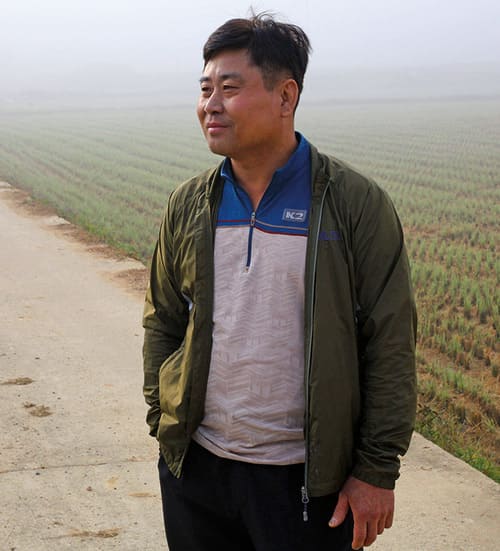 Gap Jin Kim lost all of his 1,500 hogs in the 2010 Foot and Mouth Disease outbreak. Today, he has 2,500 hogs at his farm just a few miles from the North-South Korea border.
Gap Jin Kim realized something wasn’t right with his hogs in late 2010. His piglets were dying unexpectedly and the older hogs were having trouble standing. Their feet started to develop bulging red ulcers and he could hear them screaming in pain. His farm of 1,500 hogs in Paju, South Korea, had been infected by Foot and Mouth Disease, a virus that quickly spreads to neighboring farms and regions. To stop the spread of the virus, he had to kill every hog he owned.
Gap Jin Kim lost all of his 1,500 hogs in the 2010 Foot and Mouth Disease outbreak. Today, he has 2,500 hogs at his farm just a few miles from the North-South Korea border.
Gap Jin Kim realized something wasn’t right with his hogs in late 2010. His piglets were dying unexpectedly and the older hogs were having trouble standing. Their feet started to develop bulging red ulcers and he could hear them screaming in pain. His farm of 1,500 hogs in Paju, South Korea, had been infected by Foot and Mouth Disease, a virus that quickly spreads to neighboring farms and regions. To stop the spread of the virus, he had to kill every hog he owned.
In a matter of three days, Gap Jin Kim lost all of his animals and his livelihood. “I had never experienced anything like it,” he said. “I can still hear that terrible noise they made. I didn’t think I would ever recover from that loss.”
Gap Jin Kim thought the outbreak was the end of his business as a hog farmer. He had spent more than 25 years building his farm from three sows, just a few miles from the North-South Korea border. But a call from Cargill, his long-time feed provider, convinced him to rebuild.
Through a fund created by Cargill during the outbreak, Gap Jin Kim received financial assistance and help finding healthy hogs to rebuild his herd. It took three years, but today Kim is up to 2,500 head with dreams to enter into a branded meat business of his own.
“It was an amazing moment when Cargill reached out to me,” he said. “They helped me see this job was my calling and convinced me I had the skills to come back stronger from the outbreak.”
Crisis to opportunity
Gap Jin Kim was one of many farmers that suffered entire losses of their farms during the country’s 2010-11 FMD outbreak. The virus spreads so quickly that once detected on a farm, the entire herd—and herds at nearby farms—have to be culled to stop it. In all, 30 percent of the country’s hogs, about 3.3 million, were killed in just a few months.
For Cargill’s Korea team, this was a real crisis. Cargill’s primary business in the country is supplying animal feed. Swine feed was about 60 percent of the business’s volume and 80 percent of its profit. The team went from selling nearly 130,000 metric tons of swine feed per month to 75,000 in 2010.
“Our customers were panicking and emotional fear was so high,” said Bokyeun Lee, managing director for Cargill Feed & Nutrition in Korea. “We had to find a way to help our customers and ensure we had a long-term business strategy.”
There was risk in sticking with the hog industry after the crisis, but the local Cargill team believed recovery was likely. The business backed their predictions, creating a $30 million Pork Fund to support the country. Korea coordinated their sales team and independent feed dealers nationwide to reach out individually to hog farmers with a positive message and financial assistance.
The crisis was a turning point for Cargill Korea, Lee said, because it anchored the business emotionally to their customers.
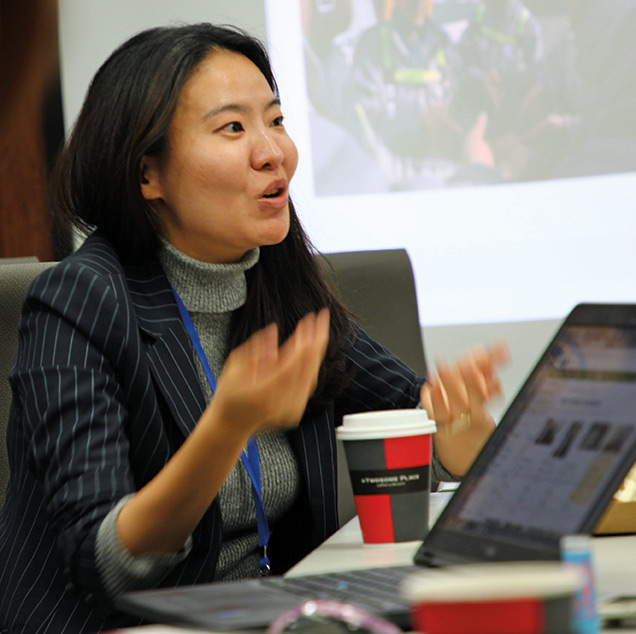 Soyeun Kim, strategic planning leader, at Cargill’s offices outside Seoul.
“You can’t manufacture the kind of trust and bond that happened,” he said. “We stood by our customers when they had lost everything in a matter of days. Getting through that crisis together secured our customers and sales team to build a long-term relationship we work every day to honor.”
Soyeun Kim, strategic planning leader, at Cargill’s offices outside Seoul.
“You can’t manufacture the kind of trust and bond that happened,” he said. “We stood by our customers when they had lost everything in a matter of days. Getting through that crisis together secured our customers and sales team to build a long-term relationship we work every day to honor.”
Last year, Cargill celebrated 50 years in South Korea, a country of 51 million people. It was Cargill Animal Nutrition’s first location in Asia. In the 1960s, Korea’s political environment became more open to foreign companies. Cargill was one of many to set up business, seeing a unique opportunity to compete in the animal feed market.
Most companies didn’t succeed, but Cargill continued to grow. In 2001, the company finalized the acquisition of global Agribrands Purina, which added to its footprint in Korea. Cargill is now the only foreign feed company with offices in the country.
“We are where we’re at today because we didn’t chase the popular things; we stuck to the basics we’re good at,” said Nikki Nam-Joo Kim, marketing communication manager. “We create high-quality products, hire the best people and focus on meeting our customers’ needs through a deep understanding of South Korean livestock. Cargill is successful when our customers thrive.”
Today, most farmers aren’t working directly with Cargill. They purchase the feed in smaller quantities at local Purina® and Nutrena® feed dealers. Outside the United States, Cargill licenses the Purina brand from Nestle Purina Petcare Co. In South Korea, independent dealers sell Purina and Nutrena products at their shops throughout the countryside. Cargill works closely with the dealers on sales training, marketing programs and solutions for their farm customers.
Cargill has approximately 560 employees in the country that work in two offices, four plants and a research facility. Cargill is the third-largest animal feed producer in the world and South Korea is a leading market in Cargill Animal Nutrition’s global portfolio, accounting for about 9 percent of its worldwide production.
“We are proud of the legacy built by the hard work of our employees in South Korea, and we are committed to continue to invest and grow in this market,” said Joe Stone, corporate senior vice president and leader of the Cargill Animal Nutrition enterprise.
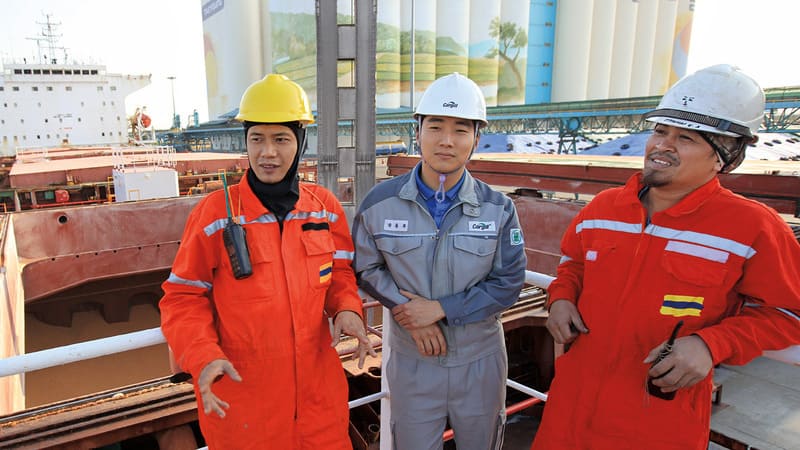 Dong-hee Kang, Cargill total quality management specialist, and two ship employees monitor the transfer of grain from the ship to the grain terminal at the Pyeongtaek port just 20 miles south of Seoul. Cargill’s PTEK animal feed plant is directly connected to the port, allowing raw material to move by pipeline at a rate of 150 tons per hour.
Dong-hee Kang, Cargill total quality management specialist, and two ship employees monitor the transfer of grain from the ship to the grain terminal at the Pyeongtaek port just 20 miles south of Seoul. Cargill’s PTEK animal feed plant is directly connected to the port, allowing raw material to move by pipeline at a rate of 150 tons per hour.
A monumental investment
When you enter Cargill’s massive 52,000-square-meter feed mill in Pyeongtaek just 20 miles south of Seoul on the Yellow Sea, it’s hard to gauge the immense amount of production happening there. Walking the floors of whirring and buzzing machinery, you might have trouble spotting an employee among all the high-tech, automated equipment.
It’s Cargill’s largest feed mill in the world, producing 870,000 tons of feed per year. The real action in the plant happens in the seven control rooms that oversee almost every mechanical process inside.
The advanced technology allows most of the 77 employees and 36 contractors to avoid physical and more dangerous jobs now performed automatically, such as the system of robots that now move about packaging and storing the finished feed in the warehouse.
The plant, known as PTEK, opened in 2015 and was celebrated as a sign of Cargill’s long-term commitment in South Korea. The facility produces swine, ruminant, poultry and pet food marketed under the Purina and Nutrena brands. The mill sends out more than 700 SKUs of finished product, some highly personalized for individual customers.
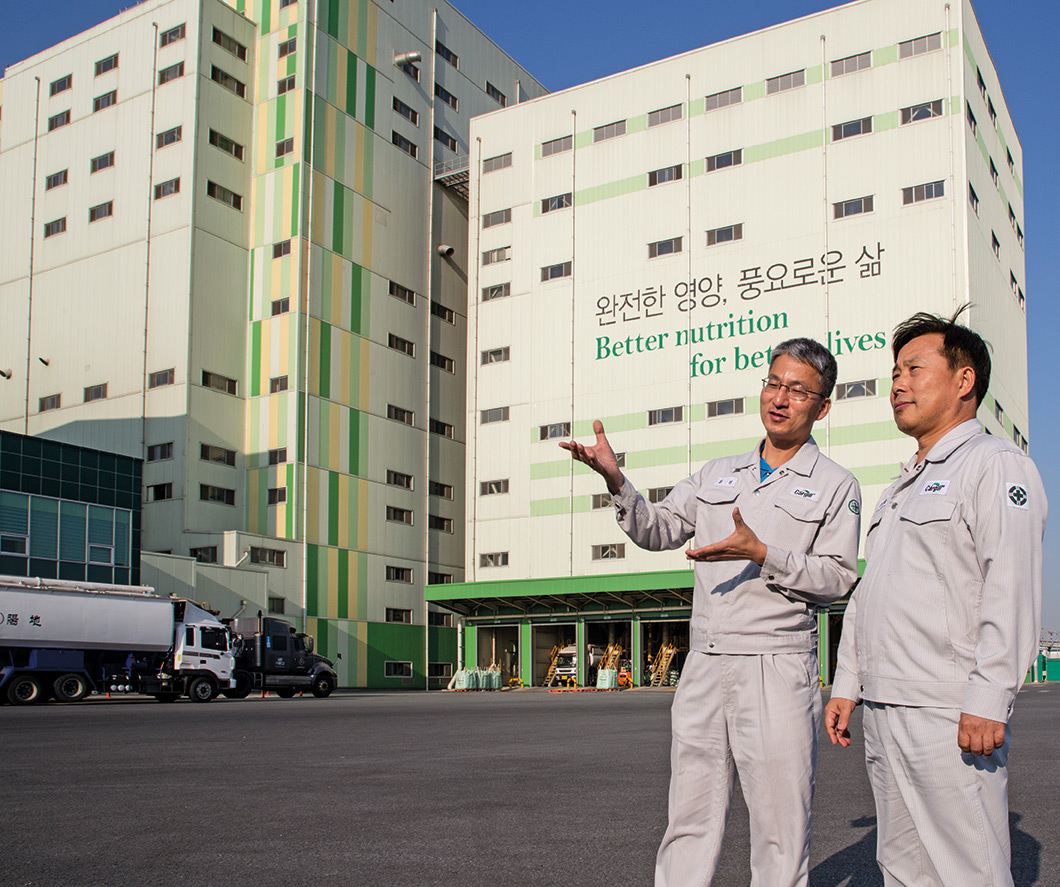 Environmental Health and Safety Manager Jin Kim and Plant Leader Jong-Un Lim outside of PTEK, Cargill’s largest animal feed mill in the world.
Pilar Cruz, group leader for Cargill Feed & Nutrition, says building the expansive plant was a strategic investment to solidify Cargill’s position as a leader in the South Korean feed market.
Environmental Health and Safety Manager Jin Kim and Plant Leader Jong-Un Lim outside of PTEK, Cargill’s largest animal feed mill in the world.
Pilar Cruz, group leader for Cargill Feed & Nutrition, says building the expansive plant was a strategic investment to solidify Cargill’s position as a leader in the South Korean feed market.
“The outlook for growth in South Korea is substantial given the demand for protein products,” she said. “Making this investment has allowed us to increase feed production while being more efficient and safe.”
Cargill relies primarily on imported ingredients to create the feed because of the country’s relatively small size and topography. A majority of the country is mountainous and isn’t ideal for large-scale production of corn, wheat and soybean meal. About 95 percent of the raw materials are imported, arriving by boat into the port.
The feed mill is directly connected to the PTEK port, allowing raw material to move by pipeline directly to the facility at a rate of 150 tons per hour. Once in the facility, the material is mixed and processed on production lines separated by species for the highest food safety and quality controls.
Constructing the facility from scratch allowed Cargill to build with a safety-first mindset, said Jin Kim, the plant’s Environment, Health and Safety manager. The pipeline alone removed the need for nearly 4,000 trucks moving on the site, which eliminated safety hazards and lowered emissions.
The highly automated process to move and produce feed abolished instances where employees in previous plants were doing more physical labor, Jin Kim said.
“PTEK is a center of excellence,” said Phil Graham, group director for Cargill Feed & Nutrition South Korea. “The technology is so advanced that customers are confident in the safety and quality of the product they receive.”
‘Pig Daddy’
Keum Young Hwang’s hog farm is tucked into the mountains outside SunCheon in the southern tip of the country. The property winds through the rugged terrain, providing stunning views of the electric fall leaves. Hwang is known as the “Pig Daddy” today given his successful business, but he isn’t one to forget how he got here: His 10,000-head hog farm sits in the region his ancestors have called home for more than 300 years. He has stacks of photo albums dating back to his first days as a farmer.
Hwang and Cargill can trace their history together, a relationship dating back 44 years. After his two-and-a-half-year military commitment, Hwang started his farm with just six pigs. His grandma, one of his role models and biggest cheerleaders, had an ambitious vision for him: He would help lead the rebirth of South Korea through agriculture after the Korean war.
It didn’t take long to see just six piglets multiply into quite the herd. Each sow produced around 10 piglets and they needed shelter. Hwang couldn’t afford to hire builders, so he got to work cutting down trees for lumber and creating bricks by hand for the first buildings on his property.
There weren’t paved roads yet, so Hwang would use his bicycle to lug bags of Purina feed to his hogs. When he needed more space, Hwang spent five years buying bits of land from individual owners to create the 180-hectare property he has today.
Hwang credits Cargill with helping his farm grow at a strong but sustainable pace. At the time, Cargill required farmers to purchase feed in cash. This meant Hwang had to be thoughtful with his finances to ensure he had enough money each month and to only order exactly what he needed.
“Other companies would let you buy as much as you asked for on credit, but Cargill forced you to only buy what you could afford,” Hwang said. “I knew Cargill wasn’t just trying to get as much profit off people, but helped them be efficient with what they needed. It taught me to be responsible, but challenge myself.”
The feed quality also kept him a loyal customer. In a highly competitive pork market, taste is king, so Hwang would only use feed that produced the best tasting meat. He says Purina feed helps him produce a sweeter product with just the right amount of fat.
Cargill helps track his data and finances, too. The sales team helped set up his wife Soo Ja Kim on a computer after she had been tracking data on white boards in the barns. The computer program, provided by Cargill, allows them to monitor everything from daily finances, employee pay and feed costs, to the best time for weaning and slaughter.
“Learning the program and getting our farm digitized are the best things I have done for this farm,” Soo Ja Kim, known as “Piggy Mommy,” said. “We wouldn’t be as productive and efficient as we are today without that assistance.”
Today, the farm uses 500 tons of feed a month and produces some of the most sought-after pork in the region. Hyun-Deck Yoo, Cargill hog sales director, said Hwang’s farm is the country’s most productive farm of this size because they’ve fully utilized all the services Cargill offers.
Hwang’s beloved grandma died before she was able to see his farm, but he says she would be proud of all he has accomplished. “Every day I think about how I can enrich my community,” he said. “We are providing jobs to the economy, donating our time and energy to local activities and producing a quality product people want to eat. I don’t think my grandma could’ve imagined what we’ve created for SunCheon.”
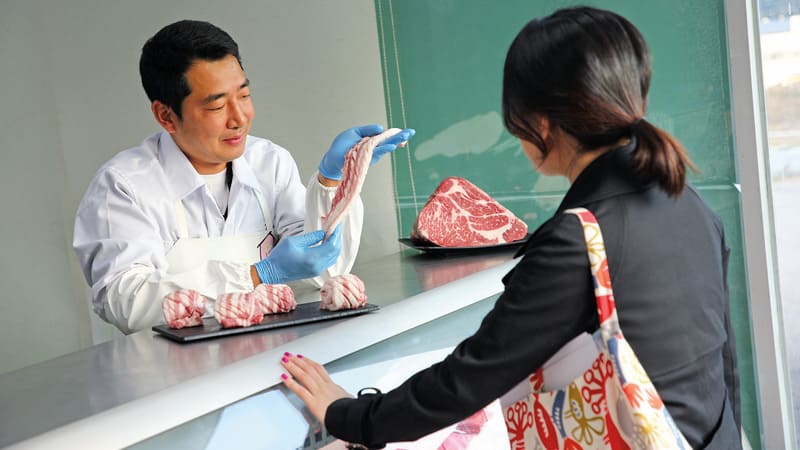 An employee at Woo-ri Meat in Pyeongtaek displays cuts of pork. The store sells Cargill-fed meat under the Dodami brand, which includes product from Gap Jin Kim's farm.
An employee at Woo-ri Meat in Pyeongtaek displays cuts of pork. The store sells Cargill-fed meat under the Dodami brand, which includes product from Gap Jin Kim's farm.
Grilled to perfection
Cargill’s customer-centered approach stretches to the end of the supply chain where hungry consumers are demanding high-quality products. In South Korea, that quintessential experience is at a Korean BBQ joint.
On a recent weeknight at Hwang-So Go Gip restaurant just outside Seoul, diners are huddled around small circular tables with inset charcoal grills. Servers bring the raw meat and fixings to the table where the customers take on the cooking and doling out of the sweet smoked bits of pork and grilled garlic that are wrapped in leaves of lettuce.
The restaurant is lively with frequent cheers of Soju, a popular rice alcohol. Owner Young Tea Kim walks through the crowd, stopping to chat with regulars and occasionally taking on the grilling duties for the table.
He’s been running the Korean BBQ restaurant for 10 years, but started with just one shop and six tables. When he started to experience lines out the door and long waits, he expanded to three locations with 125 seats.
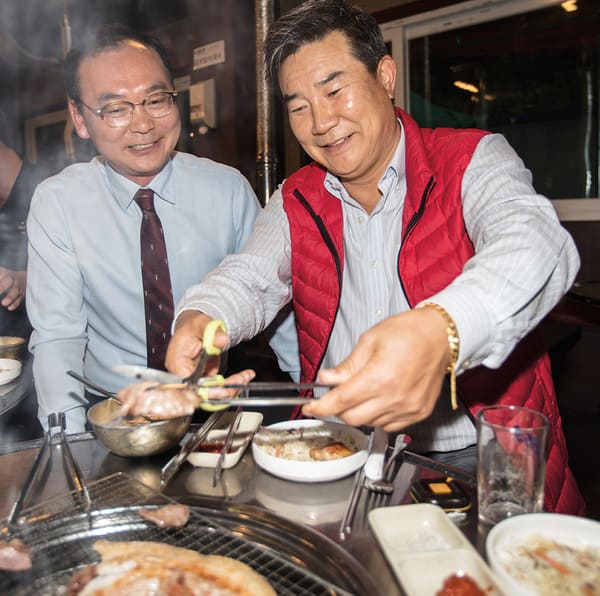 Young Tea Kim grills slices of meat at his Korean BBQ joint Hwang-So Go Gip just outside Seoul. His consumers demand fresh meat and know quality when they see it. That’s why he sells only Purina-fed pork at his restaurant.
“Koreans typically have relatively small apartments that make it hard to socialize at home,” Young Tea Kim said. “The Korean BBQ design allows families and friends to have that same experience at a restaurant. They cook their own food together and have that time to talk with one another over a special meal.”
Young Tea Kim grills slices of meat at his Korean BBQ joint Hwang-So Go Gip just outside Seoul. His consumers demand fresh meat and know quality when they see it. That’s why he sells only Purina-fed pork at his restaurant.
“Koreans typically have relatively small apartments that make it hard to socialize at home,” Young Tea Kim said. “The Korean BBQ design allows families and friends to have that same experience at a restaurant. They cook their own food together and have that time to talk with one another over a special meal.”
Pork is big business in South Korea. In 2016, per capita consumption of pork was an estimated 36.4 kg per person, only second to fish. That’s more than double the consumption of beef.
As GDP per capita in the country has increased three-fold over the past 26 years, so has the demand for protein. After the FMD outbreak that ended in 2012, pork consumption has been on the rise. There were an estimated 10.35 million head in 2016, which produced 1.8 million tons of pork.
And Korean BBQ customers are a picky bunch, Young Tea Kim said. Consumers demand fresh meat and know quality when they see it. That’s why he started and continues to sell only Purina-fed pork at his restaurant, including meat from Gap Jin Kim’s farm in Paju.
“Consumers want to know where their meat comes from, so Cargill has helped me tell that story with my products,” he said. “They know the moment you drop the meat at their table if it’s good based on the marbling of the fat in the cut.”
Understanding the story of the meat he sells has made his work more meaningful, Young Tea Kim said.
“I’m not just making money at a restaurant; I’m investing in South Korea and supporting the country’s agriculture,” he said. “I’m proud every day that I am part of that story.”
